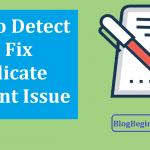Proofing reading an article is pretty time consuming job to accomplish. But to become a good proofreader it is necessary that you have the right skills.
You need to be precise, accurate and thorough with the article that you are proofreading.
Writers usually don’t want to let the proofreading cut into the writing time and hence they try finding the right balance between quality of writing and speed.
Below are few important tips on how to better proofread an article without diminishing the quality of your efforts.
These are the best and effective methods to do better proofreading on an article without omission and errors.
Contents In Page
1. Creating Checklist
The very first thing is to create the checklist of things that you are required to cover during proofreading.
You need to organize the proofreading efforts by simply writing down the aspects that you are required to cover.
The checklist you will create must comprise the basic areas like sentence structure, spelling, grammar and punctuation and more.
Check the areas in the checklist once you have completed it to ensure that all major areas of proofreading are covered.
2. Doing Preliminary Reading
Proofreaders often do a mistake of diving right into the file.
Instead they must always briefly read over the content once prior to starting the proofreading process.
During the process, you need to pen down what stands out and again come back to it when you actually start proofreading.
This effort will help you in the process as you will know where to focus most of your energies when doing proofreading of the article.
3. Working Smarter
Being the efficient proofreader you must prefer tackling with each error or omission one at a time.
Trying to fix all the errors together at once may cause more errors in the article.
So, ensure to focus on one area of error at once and fix it alone and then proceed.
You need to focus on specific areas for correction like punctuation, spelling and quality which can enhance the speed of the proofreading process.
This also enhances the proofreading skills as you will understand the strategies to pinpoint the specific mistakes at rapid pace.
4. Read The Sentences Loud
This may seem obvious to most of the people.
But the reality is that the physical act of reading the article louder helps the proofreaders to pinpoint the basic grammatical errors in the content.
This will also help you to know how the article flows.
You will easily notice whether the article is in flow and delivering the actual message or it is simply lost in the sea of pointless words and this is only possible when you read the piece louder.
No business or blogger would prefer to have blog post that is fill with fillers and pointless words which are nothing to do with their niche.
So, ensure to check for the sentence structure and ensure it is related to niche as well.
5. Allow for Breaks
When it comes to proofread any long documents or articles, it is important that you divide the amount of time spent on proofreading into small breaks.
Trying to proofread long articles at once will simply deplete your energy and even make the job of proofreading quite complicated and challenging.
So, you need to ensure that you take small time breaks in between so as to relax for some time and then continue with the remaining part of proofreading.
Allowing short breaks in between proofreading can help the proof-readers to stay focused and the probability to skip errors in the document also reduced when they are more focused.
6. Watch out for repetition
When proofreading your content, you need to watch out for common mistakes such as repetition.
Most writers tend to repeat one idea with a lot of words and sentence structures.
This can cause boredom in readers since it can indicate that you did not do enough research on the topic.
As you go through your work, get rid of any repetition to make your reader enjoy your content.
7. Double check your facts and figures
Apart from looking at spelling and grammatical errors, you need to provide your readers with accurate information. Confirm that you have included exact figures and facts from credible sources.
Ensure you identify the source of your facts to avoid plagiarising someone else’s work.
Give credit when quoting facts and figures so that your work complies with ethical standards.
8. Get help
You can get help with proofreading in different ways.
For instance, bringing in a new set of eyes can help you identify some of the mistakes as they evaluate how the audience may react to your post.
Ask your peers for some help since they can give you honest feedback before you publish the content.
You can also use a spellchecker to help you correct mistakes.
Make use of a dictionary when you are not sure of the meaning of certain words to avoid filling your post with irrelevant words that don’t add any value to it.
9. Try to read your content backward
Reading content backward may not make sense to a lot of writers, but it is an effective tactic when it comes to proofreading. This helps you identify spelling mistakes easily.
You can read the text from the last word going backward so that you concentrate on individual words instead of sentences.
It also breaks up the flow and rhythm of writing so that you can quickly identify words that you should eliminate.
10. Identify your weak points
If you have been writing for a while, you probably know your weak areas.
Every blogger has them, and they should focus on personal weakness during proofreading to boost the quality of content.
For instance, you may realize that there is a specific word that you keep on misspelling every time.
When you identify such a weakness, you can be more attentive when using the word in your posts.
Misspellings have different causes such as having poor typing skills, a mental block or lack of being familiar with certain words.
Identify the possible cause in your case and work on it.
11. Know the rules
To be a good proof-reader, you must get familiar with the rules of writing.
You can do this with the help of a handbook that discusses different writing styles.
When you go through your content and have doubts about a particular phrase, try looking it up in your handbook.
Though this may seem time-consuming at first, it helps you produce good quality content and improves your writing skills.
You will soon have the rules at your fingertips and increase your speed of writing and proofreading.
12. Concentration is a must
Immediate proofreading after writing is a poor strategy because at this point you are probably too tired to focus.
Proofreading needs a lot of focus for you to be able to identify and correct mistakes.
You, therefore, need to ensure that nothing disrupts your attention when it’s time to go through the content.
Avoid social media distraction and switch off loud music while proofreading so that your mind is focused.
13. Perform multiple passes
In as much as you work on reducing errors in your article, it is hard to make it perfect.
It is crucial to perform several passes to see how it performs and identify weak areas to bring it to perfection.
You can use online tools to perform passes.
Do not criticize yourself if the score is not as high as you expect but try to improve it every time.
14. Print out your article
It is true that words can look different on paper compared to on screen.
Printing out your work can help you catch something that your eyes may have overlooked while reading it on screen.
Use a pencil to try and underline problematic areas as you correct them accordingly.
15. Performing the Final Check
After proofreading the article for the first, you need to repeat the process again but a rapid pace.
This is called the final check or final step of proofreading. This is important process and needs to be done, especially after completing bulk proofreading or longer articles.
This final checking is like an insurance policy which ensures to find out any stray omission or errors which you might have missed in the first attempt of proofreading.
All these tips would help you to precisely proofread the articles within minimal error and efforts.
Follow these steps for a successful proofreader.








